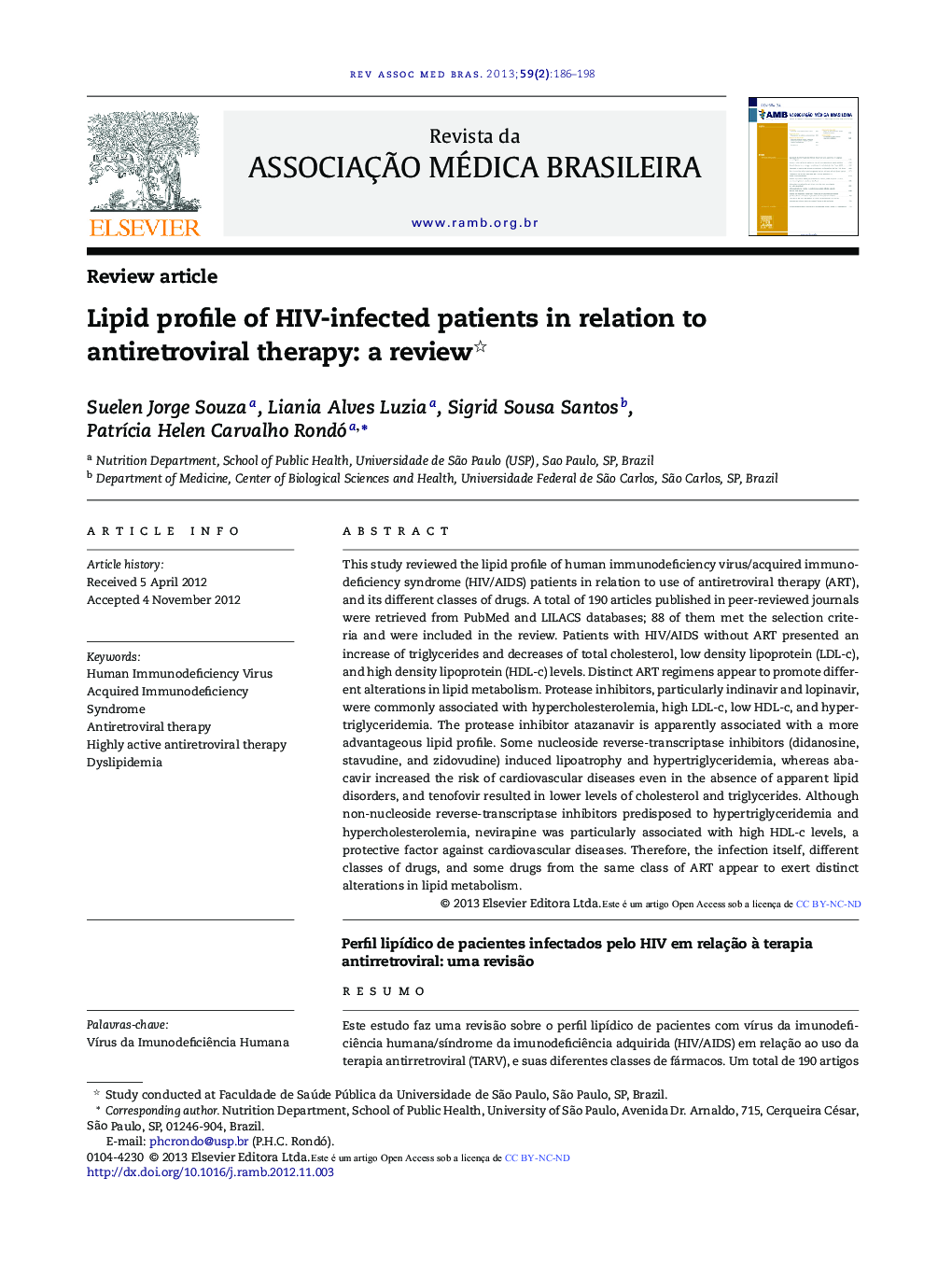| کد مقاله | کد نشریه | سال انتشار | مقاله انگلیسی | نسخه تمام متن |
|---|---|---|---|---|
| 3826337 | 1246875 | 2013 | 13 صفحه PDF | دانلود رایگان |

This study reviewed the lipid profile of human immunodeficiency virus/acquired immunodeficiency syndrome (HIV/AIDS) patients in relation to use of antiretroviral therapy (ART), and its different classes of drugs. A total of 190 articles published in peer-reviewed journals were retrieved from PubMed and LILACS databases; 88 of them met the selection criteria and were included in the review. Patients with HIV/AIDS without ART presented an increase of triglycerides and decreases of total cholesterol, low density lipoprotein (LDL-c), and high density lipoprotein (HDL-c) levels. Distinct ART regimens appear to promote different alterations in lipid metabolism. Protease inhibitors, particularly indinavir and lopinavir, were commonly associated with hypercholesterolemia, high LDL-c, low HDL-c, and hypertriglyceridemia. The protease inhibitor atazanavir is apparently associated with a more advantageous lipid profile. Some nucleoside reverse-transcriptase inhibitors (didanosine, stavudine, and zidovudine) induced lipoatrophy and hypertriglyceridemia, whereas abacavir increased the risk of cardiovascular diseases even in the absence of apparent lipid disorders, and tenofovir resulted in lower levels of cholesterol and triglycerides. Although non-nucleoside reverse-transcriptase inhibitors predisposed to hypertriglyceridemia and hypercholesterolemia, nevirapine was particularly associated with high HDL-c levels, a protective factor against cardiovascular diseases. Therefore, the infection itself, different classes of drugs, and some drugs from the same class of ART appear to exert distinct alterations in lipid metabolism.
ResumoEste estudo faz uma revisão sobre o perfil lipídico de pacientes com vírus da imunodeficiência humana/síndrome da imunodeficiência adquirida (HIV/AIDS) em relação ao uso da terapia antirretroviral (TARV), e suas diferentes classes de fármacos. Um total de 190 artigos publicados em revistas indexadas foram selecionados das bases de dados PubMed e LILACS; 88 deles preencheram os critérios de seleção e foram incluídos nesta revisão. Pacientes com HIV/AIDS sem uso de TARV apresentaram aumento de triglicérides e diminuição dos níveis de colesterol total, lipoproteína de baixa densidade (LDL-c) e lipoproteína de alta densidade (HDL-c). Distintos regimes de TARV promoveram diferentes alterações no metabolismo lipídico. Inibidores de protease, particularmente indinavir e lopinavir, foram comumente associados com hipercolesterolemia, aumento de LDL-c, diminuição de HDL-c e hipertrigliceridemia. O inibidor de protease atazanavir aparentemente está associado a menores alterações do perfil lipídico. Alguns inibidores da transcripitase reversa análogos de nucleosídeos (didanosina, estavudina e zidovudina), induziram lipoatrofia e hipertrigliceridemia, enquanto o abacavir aumentou o risco cardiovascular mesmo na ausência de aparentes distúrbios lipídicos, e o tenofovir resultou em menores níveis de colesterol e triglicérides. Embora os inibidores da transcriptase reversa não análogos de nucleosídeos possam predispor a hipertrigliceridemia e hipercolesterolemia, a nevirapina, particularmente, foi associada a maiores níveis de HDL-c, um fator de proteção contra doenças cardiovasculares. Portanto, a própria infecção, diferentes classes de fármacos e alguns fármacos da mesma classe de TARV podem exercer distintas alterações no metabolismo lipídico.
Journal: Revista da Associação Médica Brasileira - Volume 59, Issue 2, March–April 2013, Pages 186–198